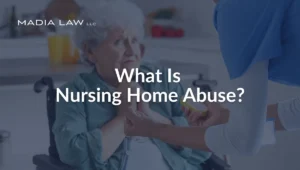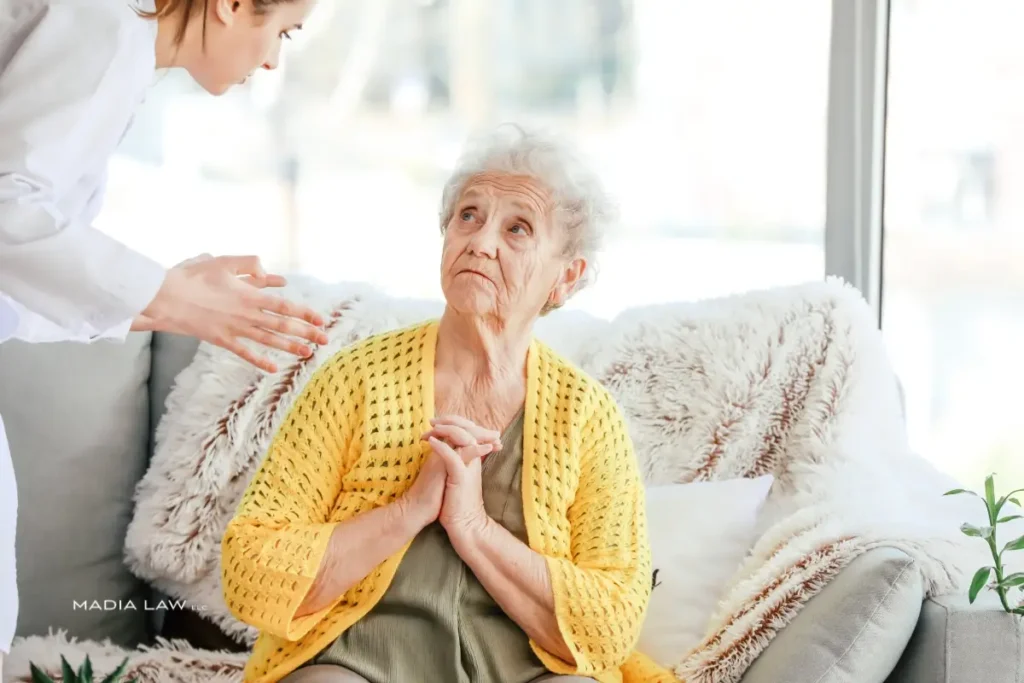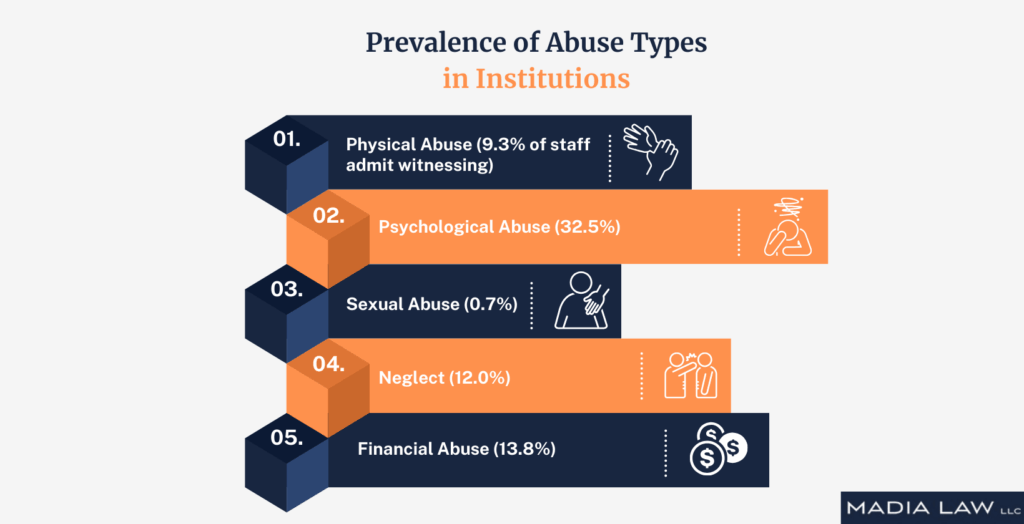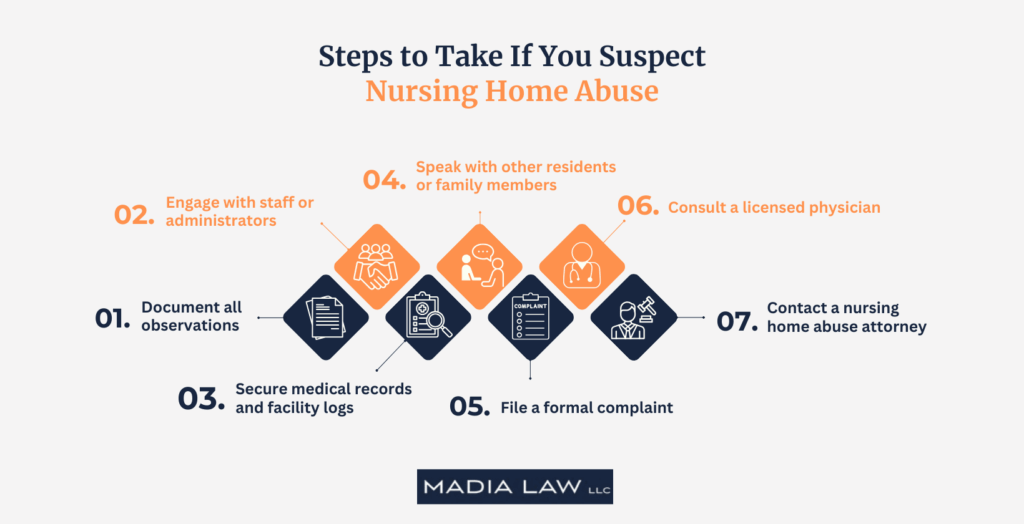
What is nursing home abuse? Nursing home abuse in Minnesota includes any failure to protect a resident’s safety, dignity, or legal rights. It may involve physical harm, emotional mistreatment, neglect, or violations of care standards under Minnesota and federal law.
Residents are protected by the Minnesota Resident Bill of Rights, which guarantees safe living conditions, proper medical attention, and respectful treatment. When these rights are ignored, families have legal options.
At Madia Law LLC, we help Minnesota families take immediate, informed legal action when care breaks down because your elders deserve more than promises. They deserve protection.
What Qualifies as Nursing Home Abuse Under the Law?
Nursing home abuse becomes a legal violation when care falls below required state or federal standards. This applies to both acts of harm and omissions that cause suffering or risk to a resident.
The scope of the issue is significant; 1 in 6 adults over age 60 report experiencing abuse in community settings, and 36% of nursing home staff admit to witnessing abuse, according to the World Health Organization and the National Center on Elder Abuse.
Federal and Minnesota Definitions of Nursing Home Abuse
Under Minnesota Statute § 626.5572 and federal elder protection laws, nursing home abuse includes:
- Neglect refers to the failure to provide necessary care, food, supervision, or shelter, placing a resident at risk of harm.
- Maltreatment includes actions or omissions that diminish a resident’s dignity, comfort, or emotional well-being.
- Willful harm involves intentional conduct that disregards a resident’s known needs, safety, or legal protections.
These standards form the basis for identifying abuse and pursuing civil claims in Minnesota.
Common Examples of Abuse in Nursing Homes
Certain incidents are clear red flags under Minnesota Statute § 626.5572 and may signal civil abuse or neglect. These examples often appear in inspection reports, witness statements, and resident complaints:
- Bedsores Caused by Lack of Repositioning: Classified as neglect when staff fail to follow mobility protocols.
- Unexplained Weight Loss: Indicates inadequate nutrition planning or failure to monitor dietary needs.
- Missed or Incorrect Medication: Suggests gaps in care coordination or failure to follow physician orders.
- Social Withdrawal or Mood Changes: Often linked to emotional or psychological neglect.
- Repeated Falls Without Updated Support Plans: Reflects poor risk assessment or failure to revise safety protocols.
For a legal consultation, call 612-349-2729
Types of Recognized Nursing Home Abuse in Elder Care Settings
Minnesota and federal law recognize seven primary types of nursing home abuse. Each represents a breach of care obligations and may result in legal liability:
| Abuse Type | Description |
|---|---|
| 1. Sexual Abuse | Any non-consensual sexual act or unwanted contact, including harassment. |
| 2. Physical Abuse | Use of force such as hitting, slapping, or rough handling that causes injury. |
| 3. Emotional or Mental Abuse | Verbal threats, humiliation, isolation, or intimidation that affect emotional well-being. |
| 4. Wrongful Death | Preventable death caused by substandard care, often tied to neglect or oversight. |
| 5. Neglect | Failure to provide food, hygiene, medical care, or supervision required by law. |
| 6. Medication Errors | Giving incorrect doses or missing medications often leads to medical harm. |
| 7. Financial Exploitation | Misuse of a resident’s funds or coercion to change financial decisions. |
Quick statistics Snapshot:(Data by WHO)
Warning Signs of Nursing Home Abuse or Neglect
Abuse is not always visible at first. In many cases, the warning signs emerge gradually, but they can signal serious care violations. Recognizing these signs early can help you act before preventable harm escalates.
Warning signs usually appear in three categories: physical, emotional, and environmental.
Physical Indicators of Abuse and Neglect
Physical signs are often the first visible indicators of nursing home abuse or neglect, and can serve as early warning signals for families. Watch for:
- Bruises or Welts: May appear in unusual locations or without explanation.
- Pressure sores (Bedsores): Usually found on the back, hips, or heels when residents aren’t moved regularly.
- Unexplained Cuts or Abrasions: Especially on hands, arms, or face.
- Poor Grooming or Hygiene: Such as dirty clothes, unwashed hair, or strong odours.
- Sudden Weight Loss: May suggest skipped meals or unmanaged medical issues.
- Visible Infections: Redness, swelling, or pus around wounds may signal neglect.
- Repeated Falls: Indicates the resident may not be properly supervised.
If you notice any of these signs, document them carefully and consider speaking with a nursing home abuse attorney to understand your options.
Behavioural and Emotional Red Flags
Emotional and psychological abuse often leaves no physical evidence, but changes in behaviour can speak volumes. These shifts may signal fear, neglect, or mistreatment inside the facility:
- Withdrawal from social activities.
- Sudden mood changes or persistent anxiety.
- Flinching or recoiling from touch.
- Avoiding eye contact or appearing fearful.
- Sleep disturbances or nightmares.
- New or worsening confusion, particularly in residents with dementia.
Environmental Clues Inside the Facility
The physical environment of a nursing home often reflects the quality of care being provided. Even small details can reveal larger problems with staffing, supervision, or facility management.
Look for these common red flags:
- Unattended Call Lights or Alarms: Often signal delayed response times or staff shortages.
- Cluttered, Dirty, or Unsanitary Areas: Indicate failure to follow basic cleanliness and infection control protocols.
- Staff Appearing Rushed, Unavailable, or Disengaged: May point to chronic understaffing or poor oversight.
Facility conditions matter. Documenting these environmental issues can support a legal claim or formal complaint if care standards are not being met.
Click to contact our personal injury lawyers today
Why Does Nursing Home Abuse Occur? Risk Factors Explained
Nursing home abuse often results from systemic issues inside the facility, not isolated incidents. Chronic understaffing, poor oversight, and administrative failures are among the most common root causes of these issues.
Recent studies show that 75% of U.S. nursing homes are understaffed, and 40% of Minnesota facilities fail to meet minimum staffing levels.
The following sections outline the key risk factors that contribute to abuse and neglect in long-term care settings.
Understaffing and Caregiver Burnout
Chronic understaffing is one of the leading causes of nursing home abuse and neglect. When there are too few staff members available to meet residents’ basic needs, critical care tasks are often delayed or missed altogether.
Examples include skipped repositioning, missed meals, or unnoticed changes in health, all of which can result in preventable harm. A staff-to-resident ratio as high as 1:18 during evening shifts significantly increases the risk of neglect and may support a legal claim under Minnesota law.
Caregiver burnout exacerbates the issue, leading to fatigue, reduced attentiveness, and diminished quality of care.
Poor Oversight and Regulatory Lapses
Long-term care facilities are subject to state and federal inspections designed to ensure regulatory compliance and resident safety. When oversight breaks down, facilities may repeatedly violate care standards without facing immediate consequences.
Common failures include:
- Infrequent audits or missed inspections.
- Delayed responses to reported violations.
- Inadequate or missing care plan documentation.
- Outdated staff training or medical equipment.
- Limited channels for family feedback or escalation.
When regulatory agencies fail to consistently monitor conditions, minor deficiencies can escalate into repeated, systemic violations, increasing both the risk of harm and potential liability.
Systemic and Cultural Issues in Long-Term Care
Underlying cultural and operational values within a facility can directly influence care quality and contribute to patterns of neglect or abuse. Two common systemic risk factors include:
- Ageism: When staff or administrators minimize the needs, pain, or autonomy of older residents, leading to dismissive or delayed care.
- Profit-driven Operations: When facilities prioritize cost-cutting over resident safety, often by reducing staff hours, skill levels, or training standards.
For example, low-cost staffing contracts may place underqualified workers in critical care roles, increasing the risk of harm while reducing accountability.
These systemic failures reflect deeper issues in how long-term care is funded, staffed, and regulated, often with direct legal consequences when resident rights are violated.
Complete a Case Evaluation form now
Legal Rights of Nursing Home Residents and Their Families
In 2022, more than 4,000 complaints were filed in Minnesota, and the Centers for Medicare & Medicaid Services issued over 10,000 citations for violations nationwide.
Understanding these rights empowers families to take action when facilities fail to fulfill their legal duties of care.
Resident Rights Under Federal and Minnesota Law
Nursing home residents are protected by clear legal standards under federal regulation (42 CFR § 483.10) and Minnesota Statute § 144.651. These laws establish enforceable rights that, when violated, may justify a civil claim.
Key resident rights include:
- Dignity and Respect: Residents must be treated as individuals, not ignored or dehumanized.
- Safe and Appropriate Medical Care: Facilities are required to meet each resident’s health needs in accordance with professional standards and guidelines.
- Freedom from Abuse or Neglect: Any physical, emotional, or financial mistreatment is a direct violation of the law.
- Privacy and Communication: Residents have the right to private communication, visits, and access to their own mail and phone calls.
- The Right to File Complaints: Grievances must be addressed promptly, without retaliation or interference.
Legal Protections for Family Members Seeking Justice
Family members have legal standing to act when a nursing home fails to meet its duty of care. Minnesota law and federal regulations provide clear rights to pursue accountability on behalf of a loved one.
These protections include:
- Access to Medical and Facility Records: Authorized representatives, including those with Power of Attorney (POA), are entitled to request full care documentation.
- Decision-making Authority: A legally designated POA or Health Care Agent may act on behalf of the resident in matters involving care, safety, or legal action.
- Right to File Formal Complaints or Initiate Civil Litigation: Family members may take legal action when there is evidence of abuse, neglect, or violation of resident rights.
Steps to Take If You Suspect Nursing Home Abuse
When signs of abuse or neglect appear, early action is critical. Prompt steps help preserve key evidence, ensure safety, and hold the facility accountable under the law.
Here is what to do if you suspect nursing home abuse:
How to File a Nursing Home Abuse Complaint in Minnesota
Filing a formal complaint is a crucial first step in documenting abuse, initiating investigations, and establishing liability. In Minnesota, you can take the following actions:
- Contact the Minnesota Adult Abuse Reporting Center (MAARC): Call 1-844-880-1574 to report suspected abuse 24/7.
- Submit a complaint to the Minnesota Department of Health: Use the department’s online portal to report violations in licensed long-term care facilities.
- Notify the Office of Ombudsman for Long-Term Care: This agency provides advocacy and assistance in resolving care-related complaints.
- Report to local law enforcement: If the resident is in immediate danger, contact police for emergency intervention.
Each report helps initiate oversight, but legal counsel ensures your complaint is thoroughly documented and aligned with potential civil claims.
How a Lawyer Helps in Nursing Home Abuse Lawsuits
An experienced nursing home abuse lawyer plays a critical role in building a civil case, protecting evidence, and holding negligent facilities accountable. Legal counsel ensures that every step from investigation to litigation aligns with state and federal elder law standards.
What a Nursing Home Abuse Lawyer Does for You:
| Task | Why It Matters |
|---|---|
| Preserves time-sensitive evidence | Ensures that medical records, staff logs, and surveillance footage are secured before they are altered or lost. |
| Builds a clear civil claim | Establishes the connection between harm, violation of duty, and facility liability under Minnesota law. |
| Communicate with insurers and facilities | Protects your rights and avoids lowball settlements or misrepresentation. |
| Represent you in negotiations or a trial | Provides strategic advocacy when disputes escalate, ensuring your case is presented with full legal weight |
Why Choose Madia Law LLC in a Nursing Home Abuse Case
Families across Minnesota turn to Madia Law LLC when serious nursing home abuse cases demand immediate legal action and experienced trial representation. Our focus is civil rights and elder neglect litigation, built on a deep understanding of state law and proven courtroom strategy.
Here is why clients trust our firm:
- Extensive experience in Minnesota elder abuse law: We are familiar with the relevant statutes, procedures, and regulators involved in these cases.
- Trial-focused from day one: Every case is prepared as if it is going to trial because that is what wins.
- Proven litigation results: Our record includes substantial verdicts and settlements in civil rights and elder care cases.
- Recognized legal credibility: Trusted by judges, opposing counsel, and advocacy groups throughout Minnesota.
- Clear, responsive communication: We keep clients informed and involved at every stage of the process.
When nursing homes fail in their duty of care, experienced legal counsel can make the difference between silence and justice.
Frequently Asked Questions About Nursing Home Abuse
Is nursing home neglect the same as nursing home abuse in legal terms?
No. Legally, abuse involves intentional acts that cause harm, while neglect refers to a failure to provide essential care, resulting in injury or risk. Both may qualify as civil violations under Minnesota law.
Do for-profit nursing homes have higher rates of abuse?
Some studies show increased citation rates in for-profit facilities, particularly those with cost-driven staffing models. However, abuse risk ultimately depends on management practices, oversight, and compliance, not ownership status alone.
How long does a nursing home lawsuit take?
Most nursing home abuse lawsuits take 12 to 24 months. The duration depends on the complexity of the case, the strength of evidence, court scheduling, and whether the case settles or proceeds to trial.
What is the average settlement for a nursing home abuse case?
The average nursing home abuse settlement ranges from $100,000 to $500,000. The value of a claim depends on factors such as the severity of harm, clear evidence of negligence or abuse, and the long-term impact on the resident.
Who regulates nursing homes in Minnesota?
The Minnesota Department of Health (MDH) regulates licensed nursing homes across the state. The agency conducts inspections, investigates complaints, and enforces safety and licensing standards.
Speak with a Minnesota Nursing Home Abuse Attorney
If you believe a nursing home resident is being abused or neglected, do not wait. Taking legal action early can preserve evidence, prevent further harm, and hold the facility accountable.
At Madia Law LLC, we represent families across Minnesota in complex elder abuse and neglect cases. Our firm is trial-focused, results-driven, and committed to helping families pursue justice when care standards are violated.
Speak directly with a nursing home abuse attorney today. Call us at 612-349-2729 or complete our secure consultation form.
Your case deserves immediate review. Let’s take the first step together.
Call 612-349-2729 or complete a Case Evaluation form





